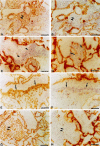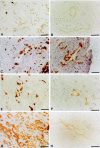Human trophoblast invasion and spiral artery transformation: the role of nitric oxide
- PMID: 10233849
- PMCID: PMC1866547
- DOI: 10.1016/S0002-9440(10)65363-1
Human trophoblast invasion and spiral artery transformation: the role of nitric oxide
Abstract
During early human pregnancy extravillous cytotrophoblasts invade the uterus and also migrate up the spiral arteries, transforming them into large vessels of low resistance. Failure of transformation has been described in pre-eclampsia, fetal growth restriction, and miscarriage. Recent evidence suggests that some maternal vessels undergo structural changes without interaction with cytotrophoblasts. The possibility arises that local vasoactive mediators such as nitric oxide result in spiral artery dilatation before their invasion. In support of this, a recent histological study in the guinea pig suggested that cytotrophoblasts expressed nitric oxide synthase (NOS) as they surrounded vessels. This study tested the hypothesis that invading cytotrophoblasts express NOS and therefore have the potential to induce vasodilatation by releasing nitric oxide. The expression of NOS on extravillous cytotrophoblasts was studied in placental bed biopsies, obtained, using a transcervical sampling technique, from normal human pregnancies between 8 to 19 weeks of gestation and in the third trimester. Whereas eNOS was expressed by syncytiotrophoblast, neither eNOS or iNOS was expressed by extravillous cytotrophoblasts at any time during invasion. The mechanisms controlling spiral artery transformation are pivotal to understanding normal and abnormal placentation. These results suggest that trophoblast-derived nitric oxide is unlikely to contribute to spiral artery dilatation.
Figures






References
-
- Pijnenborg R, Bland JM, Robertson WB, Brosens I: Uteroplacental arterial changes related to interstitial trophoblast migration in early human pregnancy. Placenta 1983, 4:397-414 - PubMed
-
- Brosens I, Robertson WB, Dixon HG: The physiological response of the vessels of the placental bed to normal pregnancy. J Pathol Bacteriol 1967, 93:569-579 - PubMed
-
- Khong TY, Liddell HS, Robertson WB: Defective haemochorial placentation as a cause of miscarriage: a preliminary study. Br J Obstet Gynaecol 1987, 94:649-655 - PubMed
-
- Khong TY: Growth: Fetus and Neonate. Edited by M Hanson, J Spencer, C Rodeck. Cambridge, Cambridge University Press, 1995
-
- McFadyen IR, Price AB, Geirsson RT: The relation of birth-weight to histological appearances in vessels of the placental bed. Br J Obstet Gynaecol 1986, 93:476-481 - PubMed
Publication types
MeSH terms
Substances
LinkOut - more resources
Full Text Sources

